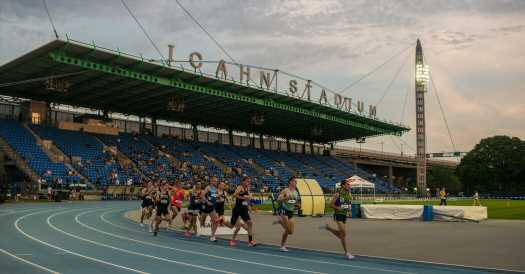To qualify for the U.S. Olympic trials in Eugene, Ore., later this month, runners had to hit certain times in certified races.
Those races are usually abundant, dotting the elite track calendar before an Olympic year and allowing athletes plenty of opportunities to punch their ticket to Hayward Field.
These past 16 months have robbed runners of many of those opportunities.
So two former collegiate runners decided to try to fill the gaps by creating their own set of races. Not only did they help many middle-distance runners land their qualifying times, they also made their events freely accessible on YouTube, a rarity in the professional running world.
The founders are Cooper Knowlton, a lawyer, and Dave Alfano, a physical therapist. They also created an Instagram account called Trials of Miles Racing, promoting “races in isolation” in March 2020. They began with small, virtual races that eventually led to small in-person races in the New York area targeted at local semi-elite runners.
Yet they found themselves attracting some of the biggest names in the sport. Alfano reached out to a wide network, and the elite standards helped keep the fields fast.
In January, a cryptic image was posted to the Instagram account. Something called the Texas Qualifiers would be held in February 2021, the post said, and it would feature the who’s who of American middle distance running, including Molly Huddle, Sara Hall, Emily Sisson, Matt Centrowitz, Ben True, Ed Cheserek and Nick Willis.
“We didn’t know what the heck we were doing,” Knowlton said. Sure, they knew how to get runners to the starting line safely, and they knew how to employ proper Covid-19 protocols. But putting on an event with Olympic-caliber entrants? That was something else entirely.
But they pulled it off. The event was sanctioned by USA Track & Field, the sport’s national governing body, and held at an undisclosed location in Austin, Texas, to keep fans at bay.
“We’re huge fans of the sport, and to have all of the pros come out and commit, it was a big opportunity,” Knowlton said. “So we hired a production team down there, and decided to put it out there for free on YouTube, and figure out the business model around that.”
Usually, if you hope to watch the fastest runners in the world, you have to do your homework. Many meets are streamed on sites like FloTrack, RunnerSpace, or USATF.TV, with each demanding a subscription fee. Others are on cable networks and usually fall in the middle of the day.
The Trials of Miles team decided to hold its events at night, when viewers are accustomed to tuning into live sports. So on Feb. 26 and 27, Trials of Miles streamed more than seven and a half hours of live track and field.
Konstanze Klosterhalfen broke the German national record in the 10,000-meter race in 31:01.71. Keira D’Amato hit the U.S. Olympic trial qualifying time by running 32:16.82, just 9 seconds under the standard. Isaiah Harris ran the men’s 800-meters in 1:46.19, and the 2016 Olympic medalist Ajee’ Wilson ran the women’s 800-meters in 1:58.93.
Altogether, both nights of the event have been viewed more than 136,000 times. Klosterhalfen’s race, later uploaded separately, has been viewed 118,000 times.
Trials of Miles kept the momentum going by hosting track events in Kansas City, Kan., on May 1 (the Kansas City Qualifier) and in New York City (the NYC Qualifier) on May 21. All meets were streamed live online.
Knowlton could count more than 10 runners who hit their first qualifying time at their meets, and said there was a laundry list of runners who hit their qualifying time again, sometimes for the first time since 2019.
“I stepped on that starting line and smiled,” Katy Kunc said of her race in Kansas, at which she qualified for the Olympic trials in the 3000-meter steeplechase. “Every time I get to a starting line I am so grateful I have the opportunity to race.”
She’s in good company for her next opportunity to race, when she joins the best runners in the nation for a shot at an Olympic team.
“I’m more confident than ever,” she continued. “It’s such a special race that I get to compete in. And it’s not like all eyes are on me, so I can go there and just see what I can do.”
All thanks to a series of meets organized in the midst of a pandemic by an attorney and a physical therapist.
Post-Run Refuel: What We’re Consuming
READ
In May 2020, Brown University announced that it would be demoting several teams, including men’s cross country and track and field.
“The implications of this decision could have set a really bad precedent for other institutions to follow,” said Russell Dinkins, who ran track at Princeton and wrote a widely shared essay that questioned Brown’s commitment to racial justice.
Less than two weeks later, Brown reversed itself and saved its men’s running teams.
Dinkins’ fight to help save men’s collegiate running programs didn’t stop there. Runner’s World spoke with the 31-year-old five-time Ivy League champion about his grass roots organizing, and what’s next.
WATCH
They may not make the Tokyo Olympics, but the Japanese track athletes Matashiro Suruga, 91, Yuzo Kudo, 92, Kozo Mitsuya, 90, and Hiro Tanaka, 90, set a world record by running the 4×400 meter relay in 8:49:01.
Their time breaks the previous world record by almost four minutes (yes, minutes). Tanaka ran the last leg in 1 minute 40 seconds.
Here’s the full video of the world record race.
One Last Rep
I’ve heard people call triathlons a four component race: swim, bike, run, eat.
The same can be said for runners. Food is fuel, and every runner needs to fuel differently.
Need some advice? This guide will walk you through some basics and dispel some of the common beliefs about food and running.
Source: Read Full Article

